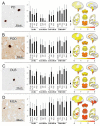Comparative survey of the topographical distribution of signature molecular lesions in major neurodegenerative diseases
- PMID: 23881776
- PMCID: PMC3872132
- DOI: 10.1002/cne.23430
Comparative survey of the topographical distribution of signature molecular lesions in major neurodegenerative diseases
Abstract
An understanding of the anatomic distributions of major neurodegenerative disease lesions is important to appreciate the differential clinical profiles of these disorders and to serve as neuropathological standards for emerging molecular neuroimaging methods. To address these issues, here we present a comparative survey of the topographical distribution of the defining molecular neuropathological lesions among 10 neurodegenerative diseases from a large and uniformly assessed brain collection. Ratings of pathological severity in 16 brain regions from 671 cases with diverse neurodegenerative diseases are summarized and analyzed. These include: 1) amyloid-β and tau lesions in Alzheimer's disease; 2) tau lesions in three other tauopathies including Pick's disease, progressive supranuclear palsy and corticobasal degeneration; 3) α-synuclein inclusion ratings in four synucleinopathies including Parkinson's disease, Parkinson's disease with dementia, dementia with Lewy bodies, and multiple system atrophy; and 4) TDP-43 lesions in two TDP-43 proteinopathies, including frontotemporal lobar degeneration associated with TDP-43 and amyotrophic lateral sclerosis. The data presented graphically and topographically confirm and extend previous pathological anatomic descriptions and statistical comparisons highlight the lesion distributions that either overlap or distinguish the diseases in each molecular disease category.
Keywords: Alzheimer's disease; Parkinson's disease; Parkinson's disease with dementia; Pick's disease; TDP; TDP-43; Tau α-synuclein; amyloid-β; amyotrophic lateral sclerosis; corticobasal degeneration; dementia with Lewy bodies; frontotemporal lobar degeneration; multiple system atrophy; progressive supranuclear palsy.
Copyright © 2013 Wiley Periodicals, Inc.
Figures




References
-
- Aarsland D, Andersen K, Larsen JP, Lolk A, Kragh-Sorensen P. Prevalence and characteristics of dementia in Parkinson disease: an 8-year prospective study. Arch Neurol. 2003;60(3):387–392. - PubMed
-
- Aarsland D, Zaccai J, Brayne C. A systematic review of prevalence studies of dementia in Parkinson’s disease. Mov Disord. 2005;20(10):1255–1263. - PubMed
-
- Alafuzoff I, Arzberger T, Al-Sarraj S, Bodi I, Bogdanovic N, Braak H, Bugiani O, Del-Tredici K, Ferrer I, Gelpi E, Giaccone G, Graeber MB, Ince P, Kamphorst W, King A, Korkolopoulou P, Kovacs GG, Larionov S, Meyronet D, Monoranu C, Parchi P, Patsouris E, Roggendorf W, Seilhean D, Tagliavini F, Stadelmann C, Streichenberger N, Thal DR, Wharton SB, Kretzschmar H. Staging of neurofibrillary pathology in Alzheimer’s disease: a study of the BrainNet Europe Consortium. Brain Pathol. 2008;18(4):484–496. - PMC - PubMed
-
- Alzheimer’s Association Alzheimer’s disease facts and figures. Alzheimer’s & dementia: the journal of the Alzheimer’s Association. 2013;9(2):208–245. - PubMed
-
- Armstrong MJ, Litvan I, Lang AE, Bak TH, Bhatia KP, Borroni B, Boxer AL, Dickson DW, Grossman M, Hallett M, Josephs KA, Kertesz A, Lee SE, Miller BL, Reich SG, Riley DE, Tolosa E, Troster AI, Vidailhet M, Weiner WJ. Criteria for the diagnosis of corticobasal degeneration. Neurology. 2013;80(5):496–503. - PMC - PubMed
Publication types
MeSH terms
Grants and funding
LinkOut - more resources
Full Text Sources
Other Literature Sources
Medical

